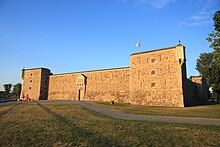Fort Chambly
Fort Chambly is a historic fort in the city of Chambly in the La Vallée-du-Richelieu Regional County Municipality, Quebec. It is since 1920 in the list of historic sites of Canada added ( National Historic Site of Canada ). The fort was part of a series of five other structures that were built along the Rivière Richelieu .
history
Fort Chambly is located below the “Chambly rapids” (rapids) on the Rivière Richelieu in the province of Quebec and was built by the French in 1711. It was the last of three forts that had been erected on the site. The first, "Fort Saint Louis", was built in 1665 by Capitaine Jacques de Chambly to protect this part of New France against attacks by the Iroquois .

After the fort slowly began to deteriorate, it was burned down by the Indians in 1702, but rebuilt in the same year. From then on it was called "Fort Chambly". However, the war between the French and the Indians had already come to an end the year before with the Peace Treaty of Montreal. The War of the Spanish Succession then began , which made itself felt in the French and British colonies. In view of a possible threat from forces from Europe, Governor Philippe de Rigaud Vaudreuil decided in 1709 to renew the building in solid masonry. The architect was Josué Boisberthelot de Beaucours, who reinforced the complex again between 1718 and 1720.
For many years "Fort Chambly" was the key position in the defense chain along the Richelieu River, this was the ideal break-in point for an invasion of New France. However, after “Fort Saint-Frédéric” had been built further south in 1731 and “Fort Saint-Jean” in 1748, “Fort Chambly” lost much of its military importance. Although it was not abandoned, it was converted into a depot and relay station. With the beginning of the Seven Years War it was reactivated and re-occupied with troops, but could not keep the British away from Montreal and Quebec.
The building then passed into British hands during the French and Indian Wars in 1760.
During the American Revolutionary War , Canada was invaded by US troops who occupied the fort on October 20, 1775. When they withdrew to Fort Ticonderoga in the spring of 1776 , they set fire to the buildings and burned the facility down, which was later repaired.
During the battles of Irish rebels against the British in the 1860s (with which one wanted to force Great Britain to withdraw from Ireland - the so-called Fenian raids) the fort was occupied by troops. After that it was abandoned and gradually fell into disrepair. In 1882, on the private initiative of Joseph-Octave Dion from Chambly, first efforts were made to restore the building. It was not until the 20th century that the Canadian government recognized Fort Chambly as a cultural and historical heritage and began its maintenance efforts. Extensive excavation work was carried out between 1965 and 1985. Today the condition of the years 1718-1720 has been restored and is maintained by "Parks Canada". It is open to the public under the name of Fort Chambly National Historic Site of Canada .
Others
On June 28, 1985, the Canadian Post issued a special postage stamp "Fort Chambly, Que.", One of 20 stamps in the "Forts Across Canada Series" (1983 and 1985).
Individual evidence
- ↑ Fort Chambly on Historic Places Canada , accessed January 3, 2013
- ^ Encyclopedia of Quebec History, Fort Chambly , accessed May 31, 2008
- ↑ Archive link ( Memento of the original from February 9, 2013 in the Internet Archive ) Info: The archive link was inserted automatically and has not yet been checked. Please check the original and archive link according to the instructions and then remove this notice.
- ↑ Canada Post stamp ( Memento of the original dated February 3, 2016 in the Internet Archive ) Info: The archive link was inserted automatically and has not yet been checked. Please check the original and archive link according to the instructions and then remove this notice.
literature
- Archeology at Fort Chambly , by Pierre Beaudet and Celine Cloutier. Ottawa: National Historic Parks and Sites, Canadian Parks Services, 1989
- McHenry, Chris: Rebel Prisoners at Quebec 1778–1783, Being a List of American Prisoners Held by the British during the Revolutionary War , Lawrenceburg, Indiana (1981).
- The Role of Fort Chambly in the Development of New France, 1665-1760 , by Cyrille Gelinas. Ottawa: National Historic Parks and Sites, Canadian Parks Services, 1983
- Dictionary of American History by James Truslow Adams , New York: Charles Scribner's Sons, 1940
- Parks Canada, Fort Chambly National Historic Site brochure, 2007.
- America's Historic Lakes, Fort Chambly on the Richelieu River
- Aimone, Alan, The Siege and Capture of Forts Chambly and St. Johns in 1775, in The Journal of America's Military Past, Vol. 28, no. 2, case 2001.
Web links
- Official Parks Canada Website - Fort Chambly National Historic Site
- Biography of Jacques de Chambly
- Google 3D warehouse
Coordinates: 45 ° 26 ′ 57 " N , 73 ° 16 ′ 36" W.


